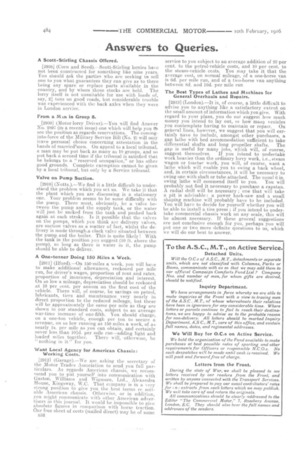Answers to Queries.
Page 18

If you've noticed an error in this article please click here to report it so we can fix it.
A Scott-Stirling Chassis Offered.
[2908] (Corn and Seed).—Scott-Stirling lorries have not been constructed for something like nine years. You should ask the parties who are seeking to sell one to you What guarantees they can give as to there being any spare or replace parts available in the country, and by whom those stocks are held. The lorry itself is not unsuitable for use with loads of, say, 2 tons on good roads, but considerable trouble was experienced with the back axles when they were in London service.
From a Man in Group 8.
[2909] (Motor-lorry Driver).—You will find Answer No. 2897 (in a recent issue) one which will help you tt see the position as regards reservations. The cominginto-force of the Military Service Bill (No. 2) will only leave personal choice concerning attestation in the hands of married'men. On appeal to a local tribunal, a man may be put back as many as 10 groups, and so put back a second time if the tribunal is satisfied that he belongs to a "reserved occupation," or has other good grounds. complete exemption cannot be given by a local tribunal, but only by a Service tribunal.
Valve on Pump Suction.
[2910] (Notts.).—We find it a little difficult to understand the problem which you set us. We take it that the plant which you are discussing is a stationary one. Your problem seems to be some difficulty with the pump. There roust, obviously, be a valve between the pump and the supply tank, or the water will just be sucked front the tank and pushed back again at each stroke. Is it possible that the valves on the pumps, which you think a-ac delivery valves, are suction valves as a matter of fact, whilst the delivery is made through.a clack valve situated between the pump and the boiler. This is quite likely! With
i the tank n the position you suggest (10 ft. above the pump), so long as there is water in it, the pump should be able to deliver.
A One-tonner Doing 150 Miles a Week.
[2911] (Ilford).—On 150o-niles a week, you will ha‘ e to make additional allowances-, reckoned per mile run, for driver's wages, proportion of rent and rates, proportion ofinsurance, depreciation and interest. On so low a mileage, depreciation should be reckoned at 10 per cent, per annum on the first cost of the vehicle. There will, of course, be savings on petrol, lubricants, tires and maintenance Very nearly in direct proportion to the reduced mileage, but these will be approximately the same per mile as thei are shown in our standard costs, subject to an average war-time increase of one-fifth. You should charge, on a one-ton vehicle, enough per ton to secure a revenue, on so low running as 150 miles a week, of as nearly is. per mile as you can obtain, and certainly never less than 10",d. per mile run—adding light and loaded miles together. There will, -.otherwise, be " nothing in it" for you.
Want Local Agency for American Chassis: Working Costs.
[29121 (Garage).—We are asking the secretary of the Motor Trades Association to send you full particulars. As regards American chassis, we recommend you to put yourself into communication with Gaston, Williams and Wiginore, Ltd., Alexandra House, Kingsway, W.C. That company is in a \cry strong position to give you the best terms re suitable American chassis. Otherwise, or in addition, you might communicate with other American advertisers in this journal. It would be impossible to give absolute figures in comparison with horse traction. Our free sheet of costs (mailed direct) may be of some
ary2 service to you subject to an average addition of 20 per cent. to the petrol-vehicle costs, and 10 per cent. to the steam-vehicle. costs. You may take it that the average cost, on normal mileage, of a. one-horse van is 6d. per mile run, and of a two-horse van anything between 8d. and 10d. per mile run.
The Best Types of Lathes and Machines for General Overhauls and Repairs.
[2913] (London).—It is, of course, a little difficult to advise you to anything like .a satisfactory extent on the small amount of information which you give. With regard to your plans, you do not suggest how much money you intend to lay out, Of how man venicles you contemplate having to maintain or repair. On general lines, however, we suggest that you will certainly have to include, amongst other purchases, a gap lathe with bed accommodation sufficient to take
differential shafts and long propeller shafts. The gap is useful for many jobs, which will, of course,
suggest themselves. If you intend to undertake work heavier than the ordinary lorry work, i.e., steam wagon or tsact:o-r work, you will, of course, want a lathe which will enable you to swing a back wheel, .and, in certain circumstances, it will be necessary to swing one with shaft or tube attached. The usual 6 in.
swing lathe will commend itself to you. You Will probably not find it necessary to purchase a capstan. A radial drill will be necessary ; one that will take a pit is advisable : a power hack-saw and a small shaping machine will probably have to be included. You will have to decide for yourself whether you will be able to install a tire press ; if you intend to undertake commercial chassis work on any scale, this will be almost necessary. If these general suggestions are not conclusive enough for you, .perhaps you will put one or two more definite questions to us, which we will do our best to answer.




















